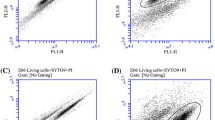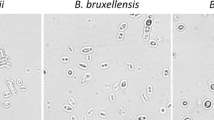Abstract
A comparative study of four different staining methods for estimation of live yeast form cells ofParacoccidioides brasiliensis was carried out. The staining methods used were fluorescent staining, vital dye exclusion tests with erythrosin B and by Janus green and lactophenol cotton blue staining. Colony forming units (cfu) of the yeast form of eightP. brasiliensis isolates on brain heart infusion agar (BHIA) supplemented with 4% horse serum plus 5%P. brasiliensis cell extract (BHIA + HS + EXT) were examined for reliability of staining in determining the number of live fungal units in eight different isolates. Cfu on BHIA + HS + EXT plates showed an excellent plating efficiency over 96% in all isolates tested. The percentage of the live cells indicated by fluorescent staining (FL) or vital dye exclusion test with erythrosin B (EB) or Janus green (JG-1) was lower than that of cfu. By contrast, the percentage due to modified dye exclusion test with Janus green (JG-2) and that due to lactophenol cotton blue staining (LPCB) showed a close correration to that of cfu. Our results indicate that the modified dye exclusion test with Janus green and lactophenol cotton blue staining are useful for estimating cell viability of yeast form cells ofP. brasiliensis.
Similar content being viewed by others
References
Goiman-Yahr M, Pine L, Albornoz MC, Yarzabal L, de Gomez MH, San Martin B, Ocanto A, Molina T, Convit J. Studies on plating efficiency and estimation of viability of suspensions ofParacoccidioides brasiliensis yeast cells. Mycopathologia 1980; 71: 73–83.
Restrepo A, Cano LE, de Bedout G, Brummer E, Stevens DA. Comparison of various techniques for determining viability ofParacoccidioides brasiliensis yeast form cells. J Clin Microbiol 1982; 16: 209–11.
Castaneda E, Brummer E, Perlman AM, McEwen JG, Stevens DA. A culture medium forParacoccidioides brasiliensis with high plating efficiency, and the effect of siderophores. J Med Vet Mycol 1988; 26: 351–8.
Singer-Vermes LM, Coavaglia MC, Kashino SS, Burger E, Calich VLG. The source of the growth-promoting factor(s) affects the plating efficiency ofParacoccidioides brasiliensis. J Med Vet Mycol 1992; 30: 261–4.
Kurita N, Sano A, Coelho KIR, Takeo K, Nishimura K, Miyaji M. An improved culture medium for detecting live yeast-phase cells ofParacoccidioides brasiliensis. J Med Vet Mycol 1993; 31: 201–5.
Calich VLG, Purchio A, Paula CR. A new fluorescent viability test for fungi cells. Mycopathologia 1978; 66: 175–7.
San Blas F, de Marco G, San Blas G. Isolation and partial characterization of a growth inhibitor ofParacoccidioides brasiliensis. Sabouraudia 1982; 20: 159–68.
San Blas F, Cova LJ. Growth curves of the yeast-like form ofParacoccidioides brasiliensis. Sabouraudia 1975; 13: 22–9.
Kashino SS, Calich VLG, Singer-Vermes LM, Abrahamsohn PA, Burger E. Growth curves, morphology and ultrastructure of tenParacoccidioides brasiliensis isolates. Mycopathologia 1987; 99: 119–28.
Sano A, Miyaji M, Nishimura K, Franco MF. Studies on the relationship between the pathogenicity ofParacoccidioides brasiliensis in mice and its growth rate under different oxygen atmospheres. Mycopathologia 1991; 114: 93–101.
Aoki Y, Marumo K, Nakanura Y, Terada H, Niikura H, Nagano H, Yamashina A, Saka S, Chikamori D. Paracoccidioidomycosis. The Infection 1984; 14: 37–40 (in Japanese).
Umeno T, Sato K, Kage M, Hachisuga H. South American blastomycosis; a case report. Jibirinshou, 1990; 83: 1559–64 (in Japanese with English summary).
Phillips HJ, Terryberry JE. Counting activity metabolizing tissue cultured cells. Exp Cell Res 1957; 13: 341–57.
Kwon-Chung KJ, Tewari R. Determination of viability ofHistoplasma capsulatum yeast cells grown in vitro: comparison between dye and colony counts methods. J Med Vet Mycol, 1987; 25: 107–14.
Miyaji M, Nishimura K. A dictionary of medical mycology. Tokyo (Japan): Kyowa Tushin Kikaku, 1991: 150–1 (in Japanese).
Research Center for Pathogenic Fungi and Microbial Toxicoses, Chiba University, eds. List of Pathogenic Fungi and Actinomycetes. Chiba, 1991.
Author information
Authors and Affiliations
Rights and permissions
About this article
Cite this article
Sano, A., Kurita, N., Iabuki, K. et al. A comparative study of four different staining methods for estimation of live yeast form cells ofParacoccidioides brasiliensis . Mycopathologia 124, 157–161 (1993). https://doi.org/10.1007/BF01103733
Received:
Accepted:
Issue Date:
DOI: https://doi.org/10.1007/BF01103733




